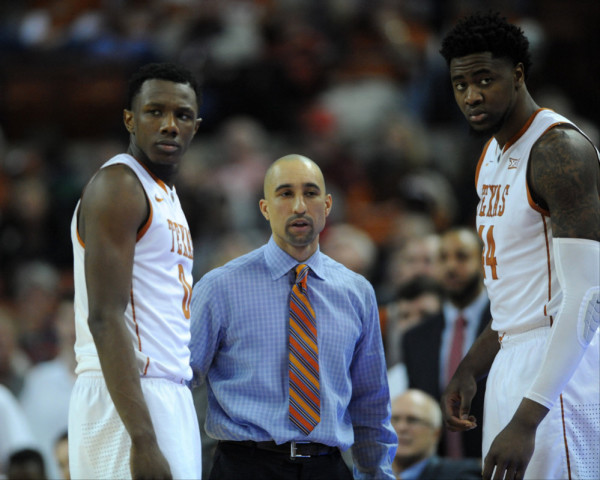Texas: Rising Fast But Not Yet a Big 12 Contender
Posted by Brian Goodman on February 3rd, 2016Monday night night, Texas rolled into Waco and beat Baylor, 67-59, earning one of those quality road wins that are so critical for NCAA Tournament resumes. For such a low-scoring game, it was an intense and fun matchup. The Bears and Longhorns fought to a draw in points in the paint (22 each) in a game that was highlighted by an entertaining and occasionally chippy battle between Rico Gathers and Prince Ibeh. In the backcourt, Javan Felix and Isaiah Taylor dissected Baylor’s zone with precision to the tune of 14 assists against just two turnovers. While big games from Gathers and Taurean Prince kept the Bears alive until the final minute, a Connor Lammert three with 44 seconds remaining ultimately sealed the win. The victory thrust Texas into a heap of second-place teams in the Big 12, a dogpile that also includes Kansas, Iowa State and Baylor. It also left some to wonder whether the Longhorns may now have a realistic shot to win the conference. It’s not a completely crazy thought, but while Texas under Shaka Smart has taken some important first steps over the last few weeks, a back-loaded league slate will leave the Longhorns with more work to do before they can be taken seriously as Big 12 title contenders.

The Longhorns are on the rise, but don’t call them Big 12 contenders just yet. (John Rivera/Icon Sportswire)
First, let’s acknowledge all the positives. Perhaps the biggest key to the Longhorns’ season thus far has been their improved ball-handling. Texas currently leads the Big 12 in offensive turnover percentage during league play and ranks 24th nationally, a year after finishing a dreadful 245th. The turnaround in that category is made all the more impressive in that Jonathan Holmes and Myles Turner — the two rotation players that Texas lost from last season — were actually the team’s most reliable ball-handlers in 2015. In other words, the Longhorns have reversed their turnover fortunes this year with largely the same personnel that made turnovers such a huge issue a year ago. Smart preached good decision-making with the ball while at VCU, and the Rams finished with top 30 offensive turnover percentages in four of his six seasons in Richmond. He’s been successful in bringing that same discipline with him to Austin.
Maybe the hottest topic when it comes to Texas, however (and rightfully so), is the emergence of Ibeh, who has come on strong on both ends of the floor. In his last four games, the senior center has averaged 11.5 points, 8.5 rebounds and 4.8 blocks per game. Additionally, he’s limited his fouls significantly over his last three games, even as he’s stayed aggressive in blocking shots. Keeping Ibeh on the floor has been hugely important to the thin Longhorns’ frontcourt as they continue to navigate life without Cameron Ridley. Texas’ recent upswing is also due in part to the development of highly-touted freshmen Kerwin Roach and Eric Davis. Roach has had a microwave-type impact lately, scoring 11 points per game in just 20.6 minutes over his last six outings. He is as much a threat to catch fire from deep as he is to use his amazing athleticism to explode to the rim. While Davis hasn’t been quite as productive as Roach, solid showings at Kansas last month (13 points and five rebounds) and against Vanderbilt last weekend (13 points and two steals) have revealed his ability to be an important piece in both Texas’ short-term prospects and beyond.
So what’s not to like about the ‘Horns’ Big 12 chances? For one thing, their league schedule. While the Big 12’s round-robin setup is a wonderful thing, the sequencing of opponents still weighs each team’s slate differently; when viewed in this light, the numbers aren’t all that kind to the Longhorns. According to KenPom, Texas has played the Big 12’s easiest league schedule to this point, and a simple look verifies that assessment: They’ve yet to play top-ranked Oklahoma and still have to travel to Hilton Coliseum. Combine those tests with remaining home games against the likes of West Virginia, Baylor and Kansas and it’s not difficult to see the role Texas’ relatively soft schedule has played in its rise. The other glaringly bad component of the schedule lies in losses to bottom-feeders Texas Tech and TCU. The Longhorns are clearly a better team now than they were when those losses occurred in early January, but unfortunately, that reality doesn’t wipe those losses away. If Texas is a legitimate threat to win the Big 12, it will need to prove it by counteracting its red marks with big efforts against the league’s top tier. While such a thing is certainly possible, it’s also something we’ll need to see to believe.
Still, the Longhorns are looking good for a third consecutive NCAA Tournament appearance, which is something that couldn’t be said in mid-January. Credit is due to Smart for changing Texas’ turnover habits and fashioning the team’s attack to its strengths rather than trying to shoehorn a group of personnel into a style of play for which it isn’t suited. In such a crowded league, sure, Texas still has a shot. It shouldn’t keep Longhorn fans from enjoying the ride or growing more confident that Smart can carry his A-10 success into a much more competitive league, but let’s wait a few more games before calling this team a Big 12 contender.











































